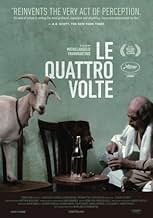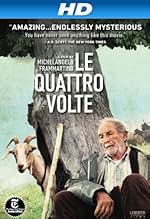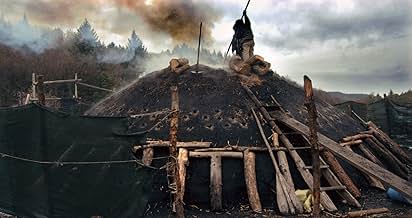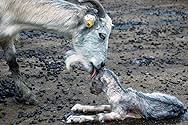Agrega una trama en tu idiomaAn old shepherd lives his last days in a quiet medieval village perched high on the hills of Calabria, at the southernmost tip of Italy. He herds goats under skies that most villagers have d... Leer todoAn old shepherd lives his last days in a quiet medieval village perched high on the hills of Calabria, at the southernmost tip of Italy. He herds goats under skies that most villagers have deserted long ago. He is sick, and believes to find his medicine in the dust he collects on... Leer todoAn old shepherd lives his last days in a quiet medieval village perched high on the hills of Calabria, at the southernmost tip of Italy. He herds goats under skies that most villagers have deserted long ago. He is sick, and believes to find his medicine in the dust he collects on the church floor, which he drinks in his water every day.
- Dirección
- Guionista
- Elenco
- Premios
- 14 premios ganados y 14 nominaciones en total
- Dirección
- Guionista
- Todo el elenco y el equipo
- Producción, taquilla y más en IMDbPro
Opiniones destacadas
The difference between one that works and others, which is the difference between meditation and sleep, is how well the filmmaker structures. It's not enough to convey an empty room, there has to be somehow someone there who is just a few words short of self and the room still being empty.
The structure here is that we have three worlds, three burials (four, if we listen to the filmmaker). Dissolution of one means birth in the next, and the whole is being spun because we breathe in the world of the film. In between we get the transient flow of things simply being themselves. We get rituals of living that pass the time, from the absurd Roman parade to sweeping a church floor to herding and playtime among baby goats, rituals about the passing of time like the one with the tallest tree cut down and erected as the center of a ceremony then symbolically cut down again, and our film as a ritual that reflects both kinds of passing.
Its function is like the mandala of Tibetans, a space where you still the mind until you begin to notice more than painted symmetry. From passing time to observation about the passing.
I would have preferred a little less quirkiness from Tati in the individual parts and a little more purity but that is a minor complaint. If you like this, look out for a guy called Ben Rivers.
The end is not an end in the classical sense and only recycled being, another mandala here. But you have to see it. What is the smoke of burned trees blowing out to the forest but transformation, the forest returning to itself? There's a beautiful Zen saying about this.
As with "The Great Silence," one of the most striking features of "Le Quattro Volte" (The Four Times) is its lack of dialogue. However, whereas for some individuals the 169 minutes of near silence in "The Great Silence" was overly taxing, in this shorter, more widely focused film - quietly reflecting aspects of life in an isolated village in Calabria – the Milanese director Michelangelo Frammartino has given us a predominantly visual poem of place, of space, of people and of the passing of time.
Although not overly religious, it is a spiritually orientated film in which we are asked to consider Pythagoras' contention that we must each know ourselves four times due to the fact that we "have four lives within us - the mineral, the vegetable, the animal and the human".
Therefore within its 88 minute run the small number of central human characters that are featured within it are soon relegated to positions of equality, or of equal vulnerability, before nature. Thus, for example, the goat-herder's animals soon come to the forefront of the film, as do other elements of the animal, vegetable and mineral kingdoms, in order to declare – seemingly – that these other realms also warrant serious and respectful consideration.
An extremely enjoyable and far-from-always-serious film, I found this a beautifully filmed, calming and thought-provoking movie.
This extensive use of long lasting shots and static moments at some point stop creating reflection moments and instead create reasons for the audience to grow bored which, to some extent, takes the effectiveness off the ending. Slow paced movies have to work in a particular way so that the audience may remain focused on the plot, to do this, things have to happen within the story presented; that rarely happens here.
So as other reviews mentioned, if the viewer has the desire to have a closer look at the rural Italian life, yeah, they'll find a sort of... well, slow view of what that is. If you're looking for an art-house kind of thing, this doesn't really work either. The real problem is that it doesn't either show enough rural life in terms of a documentary, nor is it deep enough to be a successful fiction film. Cute, but really wasn't able to engage the story.
¿Sabías que…?
- TriviaThe film is comprised of long takes. One of them lasts an astounding 8 minutes.
- Créditos curiososThe end credits also include a silver fir, the goats of Caulonia and the coal of Calabria among the cast members.
- ConexionesFeatured in Ebert Presents: At the Movies: Episode #1.15 (2011)
Selecciones populares
- How long is Le Quattro Volte?Con tecnología de Alexa
Detalles
- Fecha de lanzamiento
- Países de origen
- Sitio oficial
- Idioma
- También se conoce como
- Le Quattro Volte
- Locaciones de filmación
- Productoras
- Ver más créditos de la compañía en IMDbPro
Taquilla
- Total en EE. UU. y Canadá
- USD 152,530
- Fin de semana de estreno en EE. UU. y Canadá
- USD 16,192
- 3 abr 2011
- Total a nivel mundial
- USD 717,918
- Tiempo de ejecución1 hora 28 minutos
- Color
- Mezcla de sonido
- Relación de aspecto
- 1.85 : 1
Contribuir a esta página






















